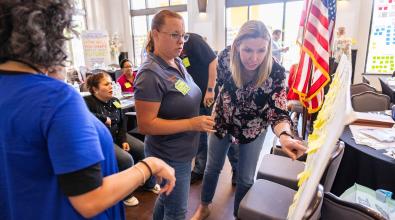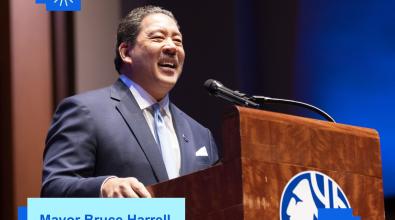 Read More
Read More
A playbook for taking missions to the next level in cities

Photos courtesy of Camden Council and iStock/Getty Images
Listen to This Article
The breadth of today’s biggest challenges has leaders at every level of government taking enterprising and expansive efforts to tackle them. Increasingly, this includes developing missions—ambitious, concrete, and cross-sectoral approaches to existential problems—as vessels for progress.
Mission-oriented innovation has long been championed by Professor Mariana Mazzucato, who is the founding director of University College London’s Institute for Innovation and Public Purpose and who has partnered with Bloomberg Philanthropies to introduce and embed this approach in city halls around the world. And now, in a just-published report encouraging the next national government of the United Kingdom to embrace missions in the face of a host of issues, Mazzucato outlines a new, concrete roadmap for governments—including local governments—to deepen these efforts.
"Thanks in no small part to Mariana's advocacy, interest in mission-based government has surged globally," said Bloomberg Philanthropies' James Anderson. "This report gives city officials a far better sense of the skills and different ways of working that are needed to launch and sustain missions that move communities forward."
Here are new, practical, and expanded capabilities Mazzucato—whose report is titled "Mission Critical: Statecraft for the 21st Century"—says governments everywhere can use to advance missions.
Deploying new budget and accountability frameworks to guide long-term focus.
Missions are based on bold goals that provide a clear direction for long-term efforts. To embed that ambition, cities can adopt new accountability and funding mechanisms that are suited to the time horizon of their aims.
Mazzucato proposes leaving behind an outdated focus on short-term gains and quick-hit performance indicators. Instead, she says, governments can benefit from providing space to iterate on and learn from longer-term projects—why some approaches are, or are not, working—rather than shelving ideas the moment they hit roadblocks. And to make missions sustainable across mayoral administrations, cities might consider new budgeting frameworks that cover longer periods in hopes of discouraging a new government from halting in-progress efforts.
In some ways, what Mazzucato is calling for here is a capacity for patience in service of successful experimentation. In a best-case scenario, cities can create what Mazzucato calls “spillover”—which is to say unexpected gains that go beyond whatever was originally intended.
For instance, in Greater Manchester, in the United Kingdom, local leaders have started a mission that includes retrofitting hundreds of thousands of homes and thousands of public buildings to be sustainable. But rather than just setting a short-term target for the number of units delivered, Mazzucato's team encouraged the city to emphasize total capacity (or the net impact of retrofitting). This sort of effort leaves space for experimentation and systemic changes in local construction—and raises the possibility that there will be multiplier effects throughout the city as local businesses and residents work to make their mission happen.
Acting as an orchestrator to galvanize city-wide action.
Just as missions call for new accountability metrics, they also invite a break from top-down approaches that have sometimes characterized major government undertakings, including those from local governments. Instead, Mazzucato sees government’s role here as that of an orchestrator taking a light-touch approach that creates space for actors to come together under a unified purpose. This is less about prescribing how every element of a mission is realized and more about setting guideposts that help local partners contribute in meaningful ways.
For instance, in Valencia, Spain, a mission geared toward achieving climate neutrality by 2030 includes an alliance the city created with a host of local organizations ranging from companies to academia. And in Greater Manchester, the city uses “challenge groups”—essentially, cross-sectoral partnerships with a focus on particular efforts, such as low-carbon buildings—to urge organizations outside of government to help make clean energy a reality.
Building storytelling capacity to create enduring public support.
Storytelling capacity takes on increased importance when it comes to missions, which depend on public buy-in over the long term. Mazzucato offers practical steps cities can use to double down on this crucial work.
That starts with making “a constant effort to connect the macro and the micro, and make clear how small changes ladder up into transformation,” she writes. She also encourages leaders to prioritize “catalyst” projects or “system demonstrators.” These are small-scale prototypes that can serve as interim subjects of storytelling along the way to make the bold goals of missions feel tangible to residents, building and maintaining enthusiasm.
In Camden, the work of bringing everyone together hinges on the We Make Camden Kit, a partnership between the borough council, residents, and local nonprofits and businesses. The idea is to fund engagement activities—such as a dinner club for disabled youth and a mentorship program for young creatives—to align residents with diverse interests and help them understand key steps in achieving missions, while also making progress on goals. These efforts can create evangelists for the mission while also raising broader public awareness through the media or storytelling, such as on We Make Camden’s blog.
Aligning investment and procurement processes with mission thinking.
Missions call for directing investment in laser-like alignment with core goals. And one crucial opportunity for cities to do this lies in procurement.
Cities have been moving toward using procurement as a strategic function for some time now, but missions represent an opportunity to go even further. A city could, for example, use long-term contracts to create demand for clean-energy products as part of an effort to reshape its local utility market—and, in doing so, make progress on a mission of sustainability. At the same time, as with the retrofitting effort in Manchester, mission-driven procurement might emphasize outcomes or impacts, rather than being solely focused on requirements.
Tying these efforts to new partnerships and institutions can be part of the equation here, too. Mazzucato highlights Camden’s Community Wealth Fund as an example. Approved last year, it will provide loans and investment to local businesses whose practices are in line with the city’s missions, while centering resident engagement in determining where awards are directed.
All of these approaches are part of delivering the overarching promise of missions: bringing society together in support of bold action on big challenges.
As Mazzucato writes, “Missions reimagine statecraft as networked, delivery-focused, innovative and collaborative, and set the state up for a more humble mode of governance, orchestrating across all layers of local, regional and devolved government and beyond, while creating a collective sense of national renewal across society.”

